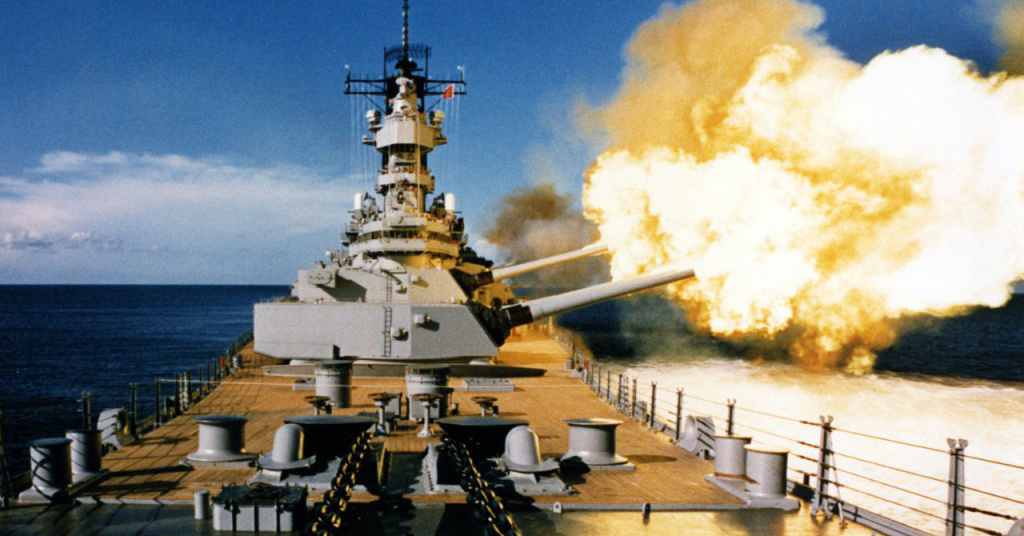There are a lot of articles that talk about the “largest naval battle,” but they don’t always agree on what battle that is. The Battle of Leyte Gulf, with nearly 200,000 participants and 285 ships, comes up often, but that isn’t the largest number of participants or ships that have clashed at a single point in history. So what’s really the largest naval battle?
The big issue is that it’s hard to define what, exactly, is the proper metric for determining the size of a battle. While land engagements are nearly always measured by the number of troops involved, naval battles can be measured by the number of ships, the size of the ships, the number of sailors, total number of vehicles and vessels, or even the size of the battlefield.
Here are three naval battles with a decent claim to “history’s largest.” One by troops involved, one by ship tonnage and area that was fought over, and one by most ships that fought.

A French map of the movements involved in the Battle of the Red Cliffs.
(Sémhur, CC BY-SA 4.0)
Battle of the Red Cliffs—850,000 troops clashed on river and land
The Battle of the Red Cliffs is likely the largest amphibious battle of all time with estimates of the troops involved going up to 880,000 with up to 800,000 marching under the Chinese General Cao Cao. Liu Bei and Sun Quan stood up a small navy and army opposition that numbered around 50-80,000. The whole fight took place in 208 AD.
If it sounds like the allied force would get railroaded, realize that they were the ones with better ships and they had hometown advantage. They sailed their ships through the rivers, likely the Han and Yangtze, set them on fire, and managed to crash them into Cao Cao’s fleet. Cao Cao’s men on the river and in camp burned.

A Japanese destroyer withdraws from the Battle of Leyte Gulf while under attack from U.S. bombers.
(Naval History and Heritage Command)
Battle of Leyte Gulf—285 ships clash over 100,000 square miles
The Battle of Leyte Gulf is what usually pops up as the top Google search for history’s largest, and it’s easy to see why. The fighting took place over 100,000 square miles of ocean, one of the largest battleships in history sunk, and 285 naval vessels and 1,800 aircraft took part. Of the ships, 24 were aircraft carriers.
It was also a key battle strategically, allowing the U.S. to re-take the Philippines and further tipping the balance of power in the Pacific in World War II in favor of the U.S. and its allies.
One odd note about Leyte Gulf, though, is that it’s often accepted as its own battle, it’s actually a term that encompasses four smaller battles, the battles of Sibuyan Sea, Surigao Strait, Cape Engano, and the Battle off Samar.

Painting depicts the Battle of Salamis where outnumbered Greek ships annihilated a Persian fleet.
(Wilhelm von Kaulbach, public domain)
Battle of Salamis—over 1,000 ships
At the Battle of Salamis in 480 BC during the Greco-Persian Wars, the Persian fleet of 800 galleys had penned 370 Greek triremes into the small Saronic Gulf. The Greek commander managed to draw the Persian fleet into the gulf, and the more agile Greek ships rammed their way through the Persian vessels.
The Persians lost 300 ships and only sank 40 Greek ones, forcing them to abandon planned offensives on land.
(Note that there are conflicting reports as to just how many ships took part in the battle with estimates ranging up to 1,207 Persian ships and 371 Greeks, but even on the lower end, the Battle of Salamis was the largest by number of ships engaged.)
If you had a battle in mind that didn’t make the list, that doesn’t mean that it’s necessarily out of the running. The Battle of Yamen saw over 1,000 ships clash and allowed the Mongol Yuan Dynasty to overtake the Song Dynasty. At the Battle of the Philippine Sea, 902 American aircraft fought 750 Japanese planes. The Battle of Jutland, the only major battleship clash of World War I, makes many people’s lists as well.
Hell, Wikipedia has a page that lists nine naval battles as potential contenders for world’s largest.


























